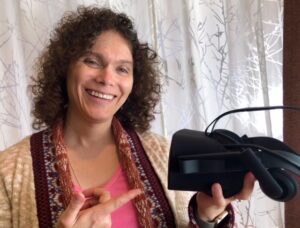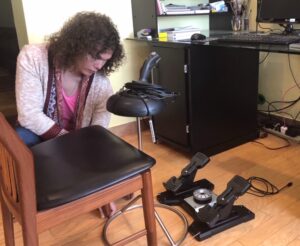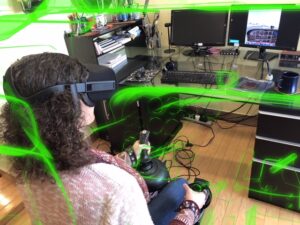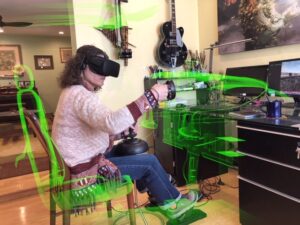
Emily Amadhia King (née Albee) is a retired animator who has worked for companies such as Walt Disney Feature Animation, NBC/Universal, and Activision. Her credits include Dinosaur, Battlestar Galactica, Babylon 5, and Kaze: Ghost Warrior. Recognized with a Peabody Award for her contributions to outstanding visual effects for the Battlestar Galactica series (the show received an Emmy for an episode she worked on), Emily is no stranger to working in the virtual world. She is now pursuing her dream of becoming a pilot and thinking outside of the box of traditional flight instruction by integrating virtual reality (VR) and simulator training to save time and money while learning to fly. We are inspired by her passion and would like to share her experiences, along with her advice, and valuable lessons she has learned along the way.
What led you to pursue VR flight training?
I always wanted to learn to be a pilot, but my career constantly seemed to get in the way. Currently I’m between careers, so I’ve got the time but not the money. I’m also 48 years old, and I can feel how much more I need repetition to learn things than I did when I was younger.
It has been a while since I had opportunities to fly in general aviation. My most recent introductory flight showed me that, if anything, I love flying even more! However, trying to make sense of the instrument panel was more than this ol’ brain of mine could process. I could see myself easily needing three to four times the minimum flight hours before I really felt comfortable and safe.
Flight time is expensive. I knew if I’m going to make this happen, I’ve got to think outside the box, and what could be farther outside the box than virtual reality?

Before I started spending my savings for flight time with fuel and an instructor, I committed to studying with Gleim Aviation, training at my own pace so I could repeatedly pass simulated versions of the exam, and logging as many flight sim hours as I needed to feel comfortable with the core elements of flying.
About 10 years ago, I did some contract work for a company that used VR to help veterans returning from war. The project was designed to assess and manage post-traumatic stress disorder (PTSD). The response from our tests was impressive, and I’ve been looking for an excuse to get my own VR system ever since.
My interest in learning to fly and VR came together when I learned that X-Plane 11 supports VR. Then I found out about the Gleim X-Plane Flight Training Course, a software course that includes dozens of videos covering all of the flight lessons, maneuvers, and tutorials directly built into the X-Plane flight simulator software. I decided to utilize these tools as the foundation for my flight training, and I want to share my experiences along the way.
Is VR flight training worth it?
I’ve been using an Oculus Rift with X-Plane 11 and the Gleim X-Plane Flight Training Course for about two and a half months now, and I can tell you: Yes, it’s worth it!
I’ve completed over 30 hours of VR flight time. Through the training course, I’ve gone from feeling utterly overwhelmed by even a basic instrument cluster to feeling comfortable flying and landing the hyper-realistic third-party Airfoil Labs Cessna 172.
(Editor’s note: The Gleim X-plane Flight Training Course modifies the default X-Plane Cessna 172 flight model to make it perform more realistically in the training course.)

Whether you are training with a traditional desktop flight simulator or using VR, here are five benefits that I have found:
- There’s no drive to the airport — your virtual plane awaits you whenever you have the time to fly.
- Your flight time is never canceled due to inclement weather — you can change the weather in X-Plane.
- You can pause the simulation and look up questions you may have or zoom in on an instrument dial to see exactly what’s going on.
- You can inexpensively train in a plethora of planes from every era that are never grounded for maintenance.
- You are flying in complete safety.
This would be a pretty compelling list of reasons just in and of itself. However, VR opens up additional possibilities that, for me, are the entirety of its selling point. These next two points are what evolve simulation training, for me, from feeling like a challenging game to feeling really darn close to the real thing.

1. You. Are. There!
I can’t stress this enough. This is breathtaking. You turn your head, lean this way and that during a clearing turn to spot other aircraft, or to look behind you out the back window before takeoff to verify that your rudder pedals are working properly. Glance down at any and all instrument readouts as if you were in a real plane. Your eyes readjust to the distance between the aircraft’s instruments and the airstrip off your left wingtip as you’re about to bank around for final approach, and it looks for all the world as if you are right there. The only thing missing is the feeling of inertia.
2. Muscle memory
Need more throttle? You just reach out with your hand to the control in the VR cockpit you see around you, “grab” the throttle, and push it to the exact place you need it to be. Using the Oculus Touch Controller, you flip switches, push buttons, turn knobs and dials, and slide throttle and mixture as if you were in the real plane.
My first time actually using a real-world plane’s throttle felt bizarre, so different from car and motorcycle throttles. But now, thanks to VR, the motions to finesse an aircraft’s throttle feel like second nature even though my training plane is just virtual. My muscles have become accustomed to the position of the controls in the VR versions of the planes I’ll likely be flying in real life. Feeling like I’m actually there in the aircraft, instrument panel and control layout just like the real thing, has been pivotal to my learning.

What about hardware?
You will need a fairly robust computer system with a minimum of an NVIDIA GTX 970 graphics card to power an VR headset, such as the Oculus Rift, to get a decent VR experience. VR headsets are still in their infancy, and their resolution is low compared to real life. If you want to read details on a dial or map, you’re going to need to move your head closer to it. You will need a yoke or stick and rudder pedals to get the feel of the flight controls.
Are there any drawbacks?
“Sim sickness.” At first, some people will experience a variant of motion sickness that happens when your eyes are telling you that you’re moving but your inner ear is saying that you’re not. I experienced this for a while but was able to slowly increase my time in the VR cockpit so that now I can fly for hours without issue. I recommend treating VR a little like swimming: wait an hour after eating before diving in.
For myself, I’ve found my jam. And I’m going to be savoring every lesson in the Gleim X-Plane Flight Training Course. I don’t feel rushed because I’m not spending my savings each time I want to fly. I get to take the time I need to hammer out all the rough spots of every maneuver in an environment that looks as if I’m in the real thing.
I’m going to be a pilot, and I’m going to be a darn good one! Come fly with me in VR!
Emily King
Gleim would like to thank Emily for her contributions. We look forward to learning more about her pursuit of becoming a pilot and sharing her story to inspire others. Learn more about Emily at EmilyKingFineArt.com.

